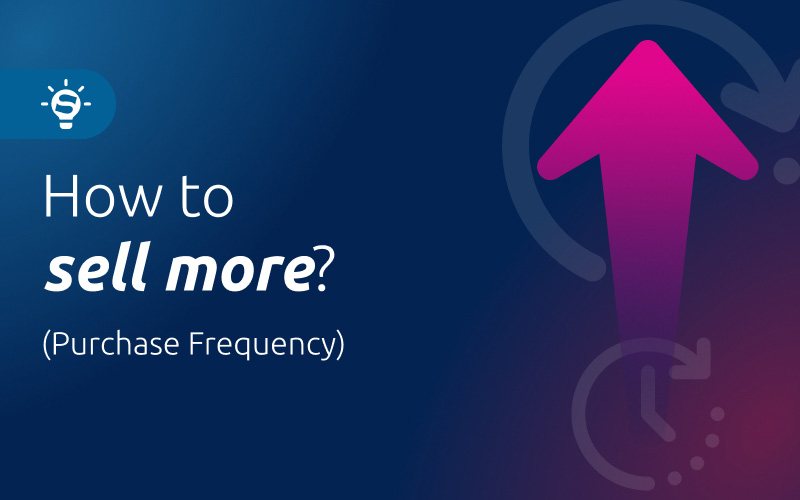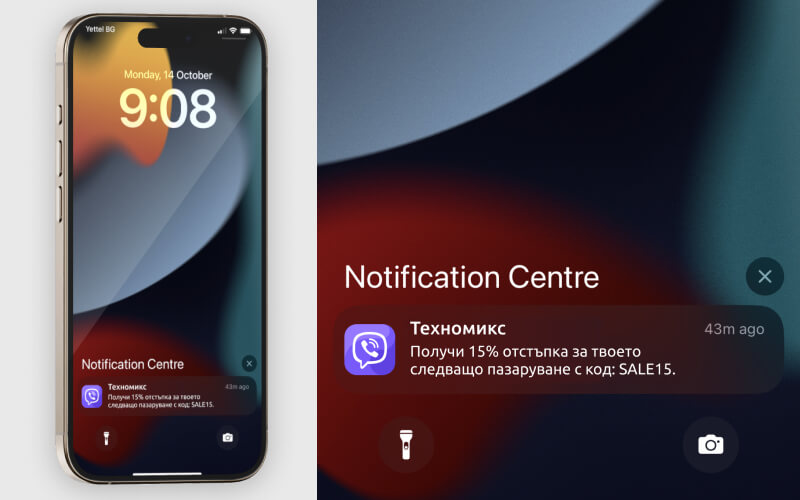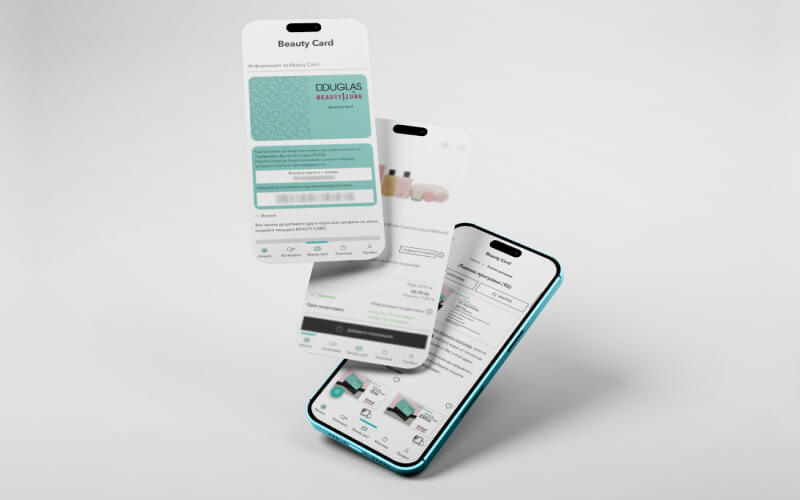How to increase Purchase Frequency in your online store?

After introducing you to the first two articles in the trilogy "How to Sell More?" related to increasing the average order value (AOV) and conversion rate, it's time to focus on another equally important aspect—retaining existing customers and increasing purchase frequency.
Many merchants aim for quick profits, investing their resources in acquiring new customers. However, they often overlook the most important asset—existing customers. A visionary approach is based on building long-term relationships with customers and turning them into regular and loyal users. Instead of focusing solely on acquiring new customers, think about how to retain the ones you’ve already gained and motivate them to return and shop repeatedly. This won't even cost you more.
Purchase frequency is a key indicator for every online retailer and marketer. Understanding how and how often customers shop is crucial for optimizing retention strategies. In the following sections, we'll share techniques to encourage customers to return and shop again.
Implement Email Marketing Software and Use Various Subscription Methods
Email marketing is one of the most effective channels for encouraging repeat purchases. Integration with platforms like Mailchimp, Klaviyo, Contact Pigeon, etc., allows the automation of marketing campaigns tailored to user behavior.
Use various strategies and automations:
- Standard emails for new products or promotions: Keep customers informed about new products and promotions, maintaining their interest.
- Personalized email campaigns based on past purchases: Send customers offers based on their previous purchases. For example, if a customer purchased shampoo, you could offer them a discount on a complementary product (hair mask, conditioner). Or if a customer bought a product expected to be used within a few months, you could send a message: "Product X is running low. Need a new one? Get it today with a 10% discount, use promo code 'restock'."
- Birthday campaigns: It’s always nice for customers to receive a birthday greeting. Adding a special discount code as a gift turns it into an irresistible offer.
- Campaigns for users who haven't ordered recently: Don't lose customers who haven’t returned on their own. Remind them of new offers and trends to encourage them to come back.
- Browse abandonment: Remind users of the products they viewed and offer them a discount or additional information to encourage them to complete a purchase.
The success of email marketing depends not only on strategies but also on feeding and maintaining your customer base. Subscription methods should be varied:
- Pop-up forms: Activate them after a certain period of interaction on the site, offering special discounts, free shipping, or another incentive (discount on the next order) in exchange for a subscription.

* For the purposes of this article, the included image is an example from a project carried out for our client Aiko XXXL.
- Use alternatives to the standard newsletter subscription (e.g., interactive games like "Wheel of Fortune"), where participants need to sign up to receive a reward.
- Subscription form at the bottom of the page, so it is visible everywhere. Use attractive messages like "Subscribe now and get a voucher for X amount off your first order!"
- Subscription form at the end of blog posts: Blogs attract organic traffic and keep customers engaged. After reading a valuable article, visitors are more likely to subscribe to not miss future posts.
Additional tips:
- Regularly conduct campaigns to delete inactive contacts: Optimize costs by removing inactive subscribers.
- Keep an eye on new automations: Use platform suggestions to learn and inspire new strategies and marketing tactics.
- Test: Conduct A/B tests on content, subject lines, sending times, and email frequency.
With the right integration of email marketing software (suitable for eCommerce) and applying diverse subscription methods, you have the opportunity to significantly increase customer engagement and encourage repeat purchases, as well as first-time purchases.
Integrate Mobile Communications – SMS/ Viber/ WhatsApp Messages (Notifications)
Sending text messages is perceived as a more personal way of contacting customers. While emails are checked an average of 1 to 3 times per day, phones are looked at over 80 times, leading to a significantly higher open rate.
Mobile communications represent an effective channel for driving sales, allowing you to send promotions, discount codes, and new product notifications to spark customer interest. For example, you can send an SMS with a promo code for 15% off the next order, valid for 7 days. The message might look like this: “Hi, [name]! Get 15% off your next purchase with code: Sale15. Valid until [date]!”

Besides encouraging more frequent purchases, mobile messages can be used to notify customers about order statuses, giving them up-to-date information about their orders. Personalized mobile marketing is another key strategy where you can send messages based on customer preferences through database segmentation. Building a closer relationship with customers through targeted and personalized messages is crucial for a successful mobile strategy.
Integrate a Loyalty Program
Loyalty programs are one of the most effective strategies for increasing purchase frequency. They motivate customers to return to use discounts on future purchases and to accumulate points for later. They strengthen long-term relationships with customers, and as a merchant, you collect valuable additional customer data.
With the growing number of loyalty programs offered by many online stores, it is essential for your store to implement such a system, ideally integrated with your physical stores. If the customer also shops in physical stores, they can present their loyalty card to accumulate points there as well. The system automatically synchronizes points and rewards, regardless of the shopping channel. In our blog, you'll find detailed information on the digitalization process of a loyalty program and customer card for a classic retailer.
Even if you don't have physical stores, a loyalty program is the perfect solution to win returning customers, and it can be integrated more easily than a mix between online and physical stores. This program can be adapted to offer rewards and incentives, encouraging customers to return for new purchases.
Over time, if you've developed a large loyal base or want to expand it dramatically, investing in a shopping mobile app is a highly recommended step. The mobile app is no longer a luxury and competitive advantage but a must-have marketing channel for merchants who want to lead. Read the case study of our client Douglas and learn more about the possibilities and advantages that the mobile app offers them.

* For the purposes of this article, the included image is an example from a project carried out for our client Douglas Bulgaria.
Encourage Customers to Create User Accounts
Creating user profiles offers significant benefits for both merchants and customers. For merchants, these profiles serve as a valuable resource, providing information crucial for better understanding customer needs and preferences. By gathering important data such as phone numbers, email addresses, and birthdates, you can implement targeted and personalized marketing campaigns, as mentioned earlier in the article. Registered users can easily be enrolled in your loyalty program, and having a wishlist (favorite products) allows you to recommend products customers genuinely want. This way, customers are showing you what items they would like to purchase. Lastly, analyzing data from user profiles helps you identify key trends in customer behavior, essential for adapting your future strategies.
Create Useful Blog Content
Don't sell to them, help them buy. Through blog articles, you can inform customers, providing them with information that helps them make informed decisions and buy. Instead of focusing solely on sales, create content that answers users' questions and needs. Invest in maintaining your blog and creating interesting articles that inform customers and help them make informed decisions.
A well-developed blog integrated into your online store not only generates traffic but also improves visibility in search engines. Quality and educational content adds value to customers, informs them about your products and services, and builds trust and a community around your brand. For example, an article like “10 Tips for Healthy and Glowing Skin During Winter” can provide not only useful advice but also include specific products that will help readers achieve their desired results.
Be sure to include blog article creation in your Search Engine Optimization (SEO) strategy. Share useful articles on your brand's social networks and include blog posts in your newsletter. Often, merchants do not send newsletters because they lack fresh and engaging content. It is precisely here that blog posts are your ace, as you can diversify by sending interesting articles, which are also a great tool for maintaining active communication and demonstrating expertise in your field.
Offer Subscription Products
Offer subscription plans for frequently ordered products or bundles of several products, with the option for regular delivery on a monthly or every three-four (or more) months basis. To attract and retain customers, provide additional benefits such as discounts, exclusive offers, and special products available only to subscribers.
For example, in the food and beverage industry, you can offer a subscription plan for a "Wine Selection." Customers will have the option to receive their preferred wines every month along with a surprise - something they don't know about (for instance, a new type of wine). In this way, customers not only get regular deliveries of their favorite drinks but also discover new flavors and experiences, making the subscription plan even more attractive.
By using the Magento platform, Stenik can set up recurring automatic payments from the customer's credit card. This way, regular income is automatically generated. The possibility of implementing recurring payments may depend on the merchant's virtual POS terminal provider.
Regular Customer Preference Surveys
Regularly conduct surveys to understand what new products or flavors your customers would like. You can send surveys via newsletters or include them as pop-ups on the website to stay informed about customer expectations and needs. This allows you, as a merchant, to improve your offerings and enhance your online store.
Inform customers about the survey results and how their opinions have influenced decisions. Let them know about specific changes made in response to their feedback so they feel valued. Additionally, customer surveys can also be used for testing new products or other ideas.
Improve the Return and Exchange Process (RMA)
A simplified return and exchange process helps customers to order repeatedly. Create a clear and intuitive process for returning orders or individual products from an order. When customers know they can easily return or exchange items, they are more likely to order.
Provide detailed and easily accessible return instructions, quick approval of requests, and flexible return options. Attach return instructions to each order and include a prepaid label for a specific courier, or allow customers to choose a courier themselves. Packaging products separately will allow customers to keep one item and return another during inspection, even at the time of delivery, for example, when ordering the same product in different sizes.
Provide the option for customers to request a return directly from their profile and choose a courier to pick up the package at a specified address, return the product in-person at a parcel locker, or at a courier office. Offer the possibility to return goods to your physical store. As an added value and benefit, offer an extended return period beyond the legal requirement. Include a short form for each return to gather information about the reason for the return. This feedback will help you identify product or process issues and improve the customer experience.
For more information on integrating a return management system (RMA), read our blog post.
Thus, we have guided you through three key points that every growing online merchant should focus on when building a successful online sales strategy:
How to increase the Average Order Value (AOV)
How to increase the conversion rate
How to increase the purchase frequency.
FAQ
We hope this has been helpful!
At Stenik, we are available to integrate solutions for your online store or upgrade them in a personalized way to meet your business and technical needs. Contact us to answer any of your questions.
Published in:
e-commerce tips
